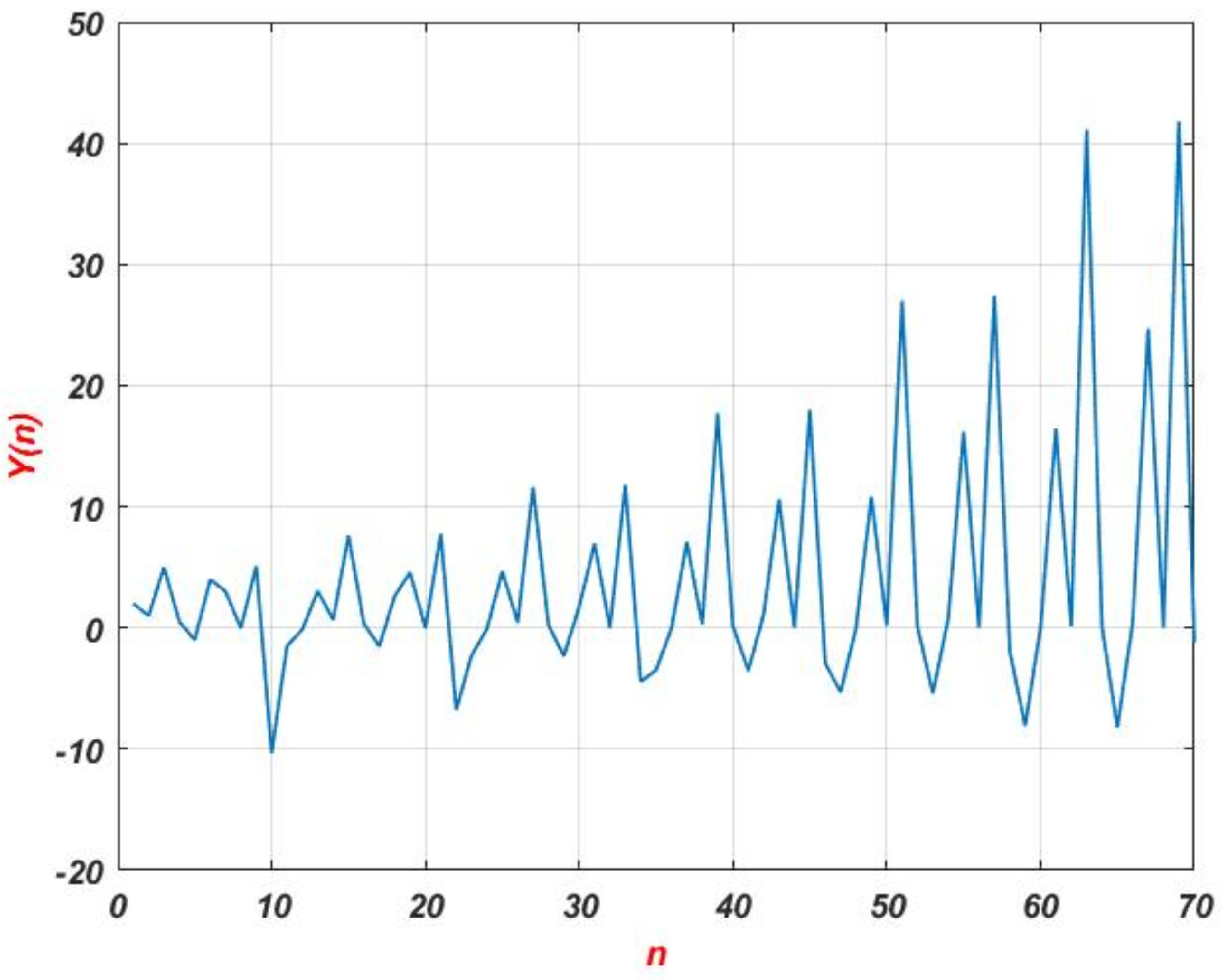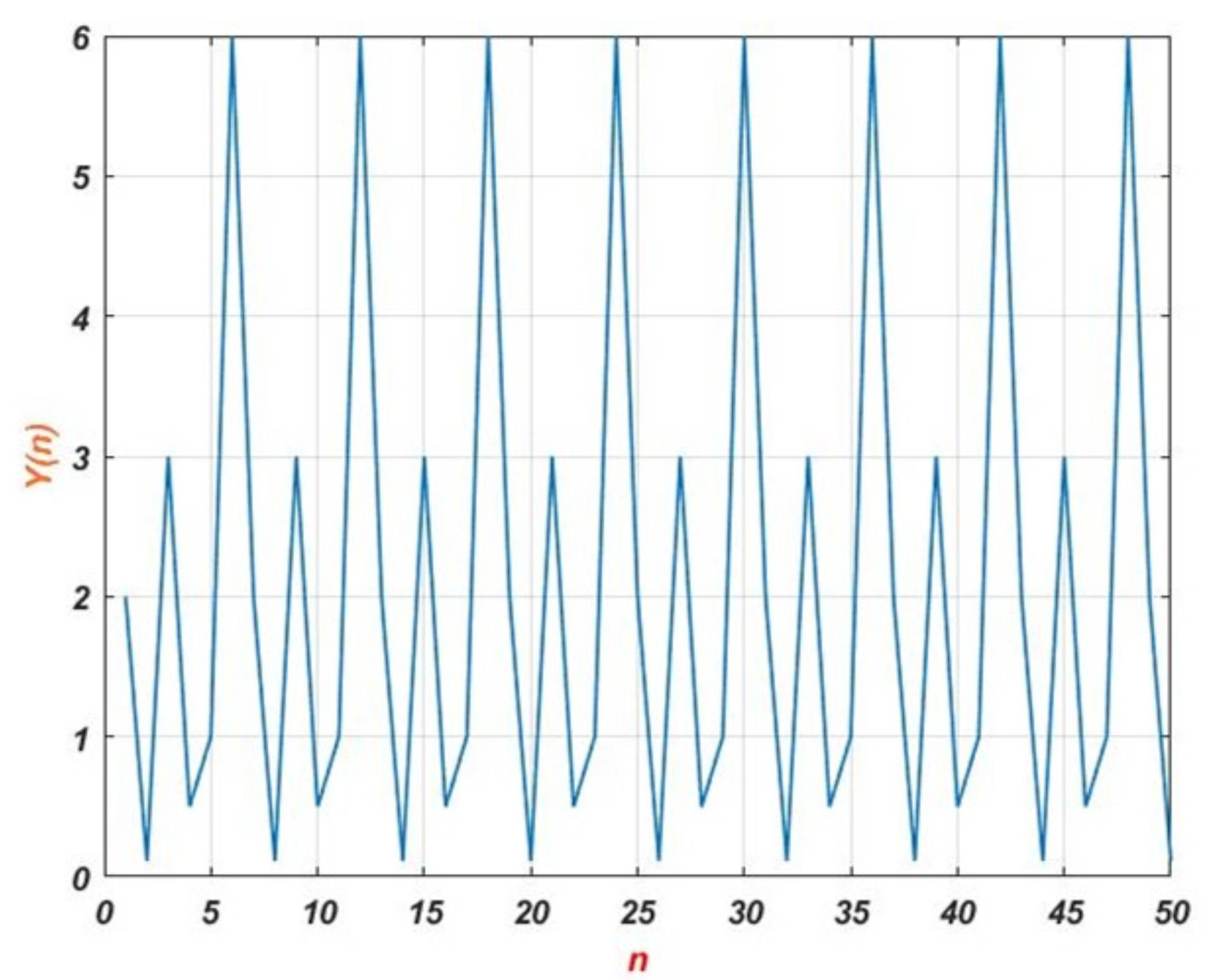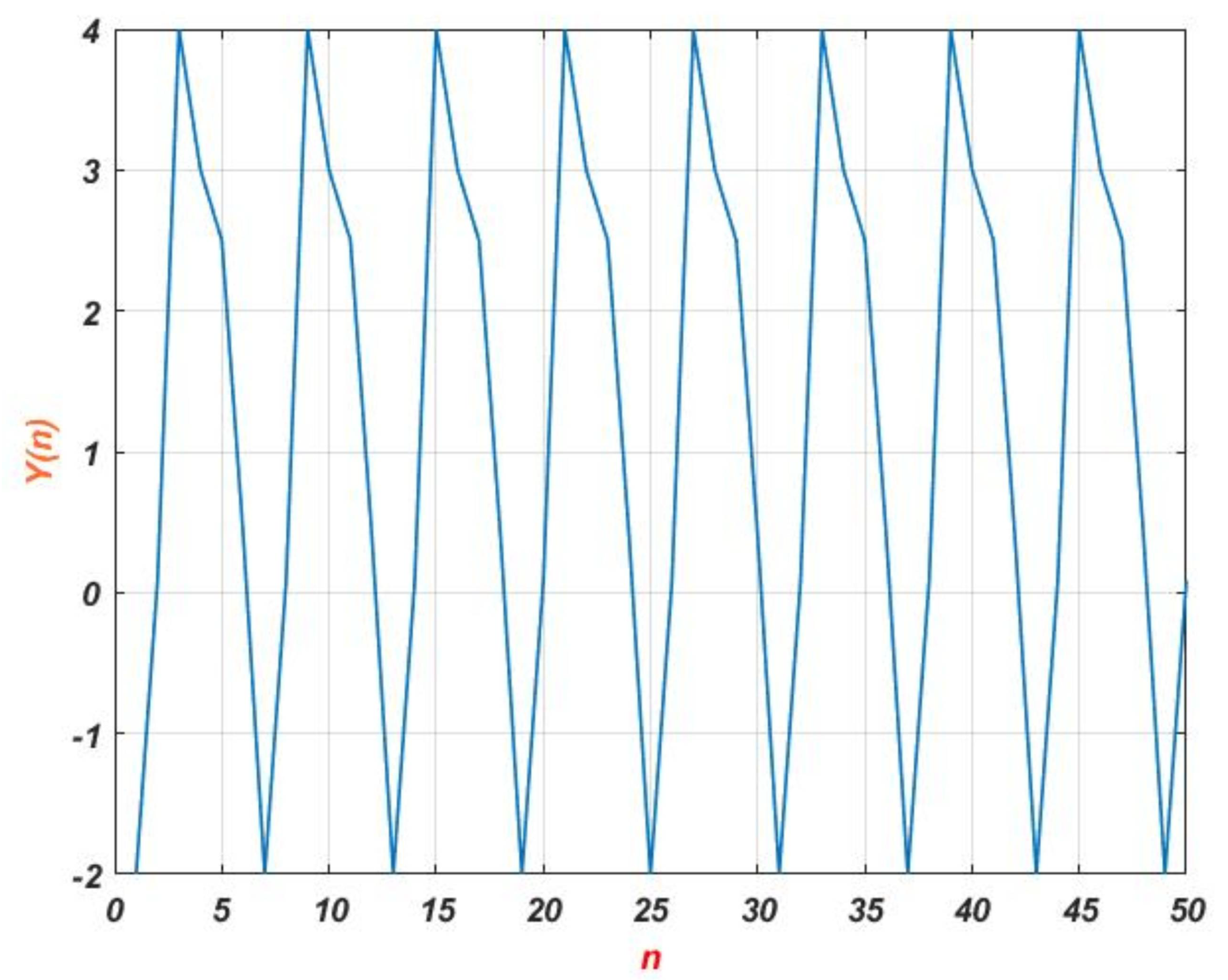On the Dynamics of Some Higher-Order Nonlinear Difference Equations
Abstract
1. Introduction
2. Definitions and Fundamental Theorems
- Locally stable if, for every , there exists such that for every , withwe have
- Locally asymptotically stable if is a locally stable solution of Equation (2) and there exists such that for every , withwe have
- A global attractor if, for every , we have
- Globally asymptotically stable if is locally stable and also a global attractor of Equation (2).
- Unstable if is not a locally stable solution of Equation (2).
3. The First Case
Form of Solution
4. The Second Case
Form of Solution
5. The Third Case
6. The Fourth Case
7. Numerical Results
8. Conclusions
Author Contributions
Funding
Data Availability Statement
Conflicts of Interest
References
- Kerker, M.A.; Hadidi, E.; Salmi, A. Qualitative behavior of a higher-order nonautonomous rational difference equation. J. Appl. Math. Comput. 2020, 64, 399–409. [Google Scholar] [CrossRef]
- Almatrafi, M.; Elsayed, E.M.; Alzahrani, F. Investigating Some Properties of a Fourth Order Difference Equation. J. Comput. Anal. Appl. 2019, 28, 243–253. [Google Scholar]
- Garic-Demirovic, M.; Nurkanovic, M.; Nurkanovic, Z. Stability, periodicity and Neimark-Sacker bifurcation of certain homogeneous fractional difference equations. Int. J. Differ. Equations 2017, 12, 27–53. [Google Scholar]
- Tollu, D.T.; Yazlik, Y.; Taskara, N. On a solvable non-inear difference equation of higher order. Turk. J. Math. 2018, 42, 1765–1778. [Google Scholar] [CrossRef]
- El-Metwally, H.; Elsayed, M.E. Qualitative Study of Solutions of Some Difference Equations. Abstr. Appl. Anal. 2012, 16, 248291. [Google Scholar] [CrossRef]
- Jia, L. Dynamic behaviors of a class of high-order fuzzy difference equations. J. Math. 2020, 2020, 1737983. [Google Scholar] [CrossRef]
- Kara, M.; Yazlik, Y.; Tollu, D.T. Solvability of a system of higher order nonlinear difference equations. Hacet. J. Math. Stat. 2020, 49, 1566–1593. [Google Scholar] [CrossRef]
- Ladas, G.; Tzanetopoulos, G.; Tovbis, A. On May’s host parasitoid model. J. Differ. Equations Appl. 1996, 2, 195–204. [Google Scholar] [CrossRef]
- Alayachi, H.S.; Noorani, M.S.; Khan, A.Q.; Almatrafi, M.B. Analytic solutions and stability of sixth order difference equations. Math. Probl. Eng. 2020, 2020, 1230979. [Google Scholar] [CrossRef]
- Ahlbrandt, C.D.; Peterson, A.C. Discrete Hamiltonian Systems: Difference Equations, Continued Fractions, and Riccati Equations; Kluwer Academic Publishers: Amsterdam, The Netherlands, 1996. [Google Scholar]
- Alharbi, T.D.; Elsayed, M.E. Forms of Solution and Qualitative Behavior of Twelfth-Order Rational Difference Equation. Int. J. Differ. Equations 2022, 17, 281–292. [Google Scholar]
- Alharbi, T.D.; Elsayed, M.E. The Solution Expressions and the Periodicity Solutions of Some Nonlinear Discrete Systems. Pan-Amer. J. Math. 2023, 2, 3. [Google Scholar] [CrossRef] [PubMed]
- Alotaibi, A.M.; El-Moneam, M.A. On the dynamics of the nonlinear rational difference equation . AIMS Math. 2022, 7, 7374–7384. [Google Scholar] [CrossRef]
- Beverton, R.J.H.; Holt, S.J. On the Dynamics of Exploited Fish Populations, Fishery Investigations Series II; Blackburn Press: Caldwell, NJ, USA, 2004. [Google Scholar]
- Bektesevic, J.; Mehuljic, M.; Hadziabdic, V. Global Asymptotic Behavior of Some Quadratic Rational Second-Order Difference Equations. Int. J. Differ. Equations 2017, 20, 169–183. [Google Scholar]
- Cull, P.; Flahive, M.; Robson, R. Difference Equations: From Rabbits to Chaos, Undergraduate Texts in Mathematics; Springer: Berlin/Heidelberg, Germany, 2005. [Google Scholar]
- Din, Q.; Elsayed, M.E. Stability analysis of a discrete ecological model. Comput. Ecol. Softw. 2004, 4, 89–103. [Google Scholar]
- Dekkar, I.; Touafek, N.; Din, Q. On the global dynamics of a rational difference equation with periodic coefficients. J. Appl. Math. Comput. 2019, 60, 567–588. [Google Scholar] [CrossRef]
- Elsayed, M.E.; Alharbi, K.N. The expressions and behavior of solutions for nonlinear systems of rational difference equations. J. Innov. Appl. Math. Comput. Sci. (JIAMCS) 2022, 2, 78–91. [Google Scholar]
- Elsayed, M.E.; Alshareef, A. Qualitative Behavior of A System of Second Order Difference Equations. Eur. J. Math. Appl. 2021, 1, 15. [Google Scholar] [CrossRef]
- Elsayed, E.M.; Alofi, B.S.; Khan, A. Qualitative Behavior of Solutions of Tenth-Order Recursive Sequence Equation. Math. Probl. Eng. 2022, 10, 5242325. [Google Scholar] [CrossRef]
- Gümüş, M.; Abo-Zeid, R. Qualitative study of a third order rational system of difference equations. Math. Moravica 2021, 25, 81–97. [Google Scholar] [CrossRef]
- Jana, D.; Elsayed, M.E. Interplay between strong Allee effect, harvesting and hydra effect of a single population discrete—Time system. Int. J. Biomath. 2016, 9, 58–1793. [Google Scholar] [CrossRef]
- Ma, W.X. Global behavior of a higher-order nonlinear difference equation with many arbitrary multivariate functions. East Asian J. Appl. Math. 2019, 9, 643–650. [Google Scholar]
- Moaaz, O.; Chalishajar, C.; Bazighifan, O. Some qualitative behavior of solutions of general class difference equations. Mathematics 2019, 7, 585. [Google Scholar] [CrossRef]
- Murray, J.D. Mathematical Biology: An Introduction; Kluwer Academic Publishers: New York, NY, USA; Springer: Berlin/Heidelberg, Germany, 2002. [Google Scholar]
- Qian, C.; Smith, J. On quasi-periodic solutions of forced higher order nonlinear difference equations. Electron. J. Qual. Theory Differ. Equations 2020, 6, 20. [Google Scholar] [CrossRef]
- Stević, S. On some solvable systems of difference equations. J. Appl. Math. Comput. 2012, 218, 5010–5018. [Google Scholar] [CrossRef]
- Mahmood, B.A.; Yousif, M.A. A novel analytical solution for the modified Kawahara equation using the residual power series method. Nonlinear Dyn. 2017, 89, 1233–1238. [Google Scholar] [CrossRef]
- Yazlik, Y.; Kara, M. On a solvable system of difference equations of higher-order with period two coefficients. Commun. Fac. Sci. Univ. Ank.-Ser.-Math. Stat. 2019, 68, 1675–1693. [Google Scholar] [CrossRef]
- Zayed, E.M.E. On the dynamics of a new nonlinear rational difference. Dyn. Contin. Discret. Impuls. Syst. Math. Anal. 2020, 27, 153–165. [Google Scholar]
- Kulenovic, M.R.S.; Ladas, G. Dynamics of Second Order Rational Difference Equations with Open Problems and Conjectures; Chapman & Hall: New York, NY, USA, 2001. [Google Scholar]
- Kocic, V.L.O.; Ladas, G. Global Behavior of Nonlinear Difference Equations of Higher Order with Applications; Kluwer Academic Publishers: Dordrecht, The Netherlands, 1993. [Google Scholar]







Disclaimer/Publisher’s Note: The statements, opinions and data contained in all publications are solely those of the individual author(s) and contributor(s) and not of MDPI and/or the editor(s). MDPI and/or the editor(s) disclaim responsibility for any injury to people or property resulting from any ideas, methods, instructions or products referred to in the content. |
© 2024 by the authors. Licensee MDPI, Basel, Switzerland. This article is an open access article distributed under the terms and conditions of the Creative Commons Attribution (CC BY) license (https://creativecommons.org/licenses/by/4.0/).
Share and Cite
Alharbi, T.D.; Hasan, M.R. On the Dynamics of Some Higher-Order Nonlinear Difference Equations. Mathematics 2024, 12, 3810. https://doi.org/10.3390/math12233810
Alharbi TD, Hasan MR. On the Dynamics of Some Higher-Order Nonlinear Difference Equations. Mathematics. 2024; 12(23):3810. https://doi.org/10.3390/math12233810
Chicago/Turabian StyleAlharbi, Turki D., and Md Rifat Hasan. 2024. "On the Dynamics of Some Higher-Order Nonlinear Difference Equations" Mathematics 12, no. 23: 3810. https://doi.org/10.3390/math12233810
APA StyleAlharbi, T. D., & Hasan, M. R. (2024). On the Dynamics of Some Higher-Order Nonlinear Difference Equations. Mathematics, 12(23), 3810. https://doi.org/10.3390/math12233810






